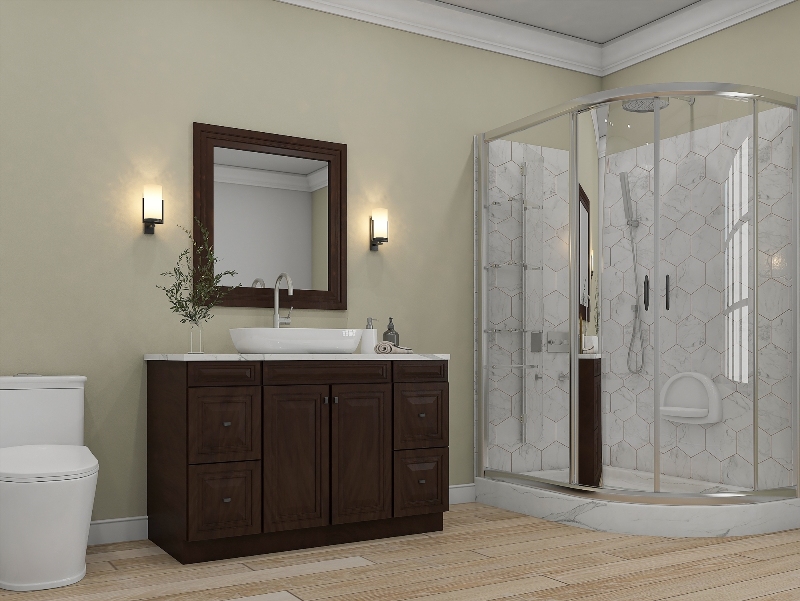Are bathroom and kitchen cabinets interchangeable? This is a common question that arises during home renovation projects. While bathroom and kitchen cabinets may seem similar at first glance, a closer examination reveals significant differences. Let’s delve into the distinctions between bathroom and kitchen cabinets and understand why consulting an expert designer is crucial when selecting the right cabinets for your renovated bathroom and kitchen.
Dimensionally Different
While they may appear similar, kitchen cabinets and bathroom cabinets serve distinct purposes with variations in dimensions and sizes. Designer kitchen cabinets Bahamas are characterized by their larger and taller stature, engineered to hold bulkier kitchen essentials like dishes, utensils, and food items. These cabinets feature expansive drawers and shelves designed to accommodate most kitchen necessities.
Conversely, bathroom cabinets are characterized by their shorter and narrower build, tailored for lighter items such as toiletries, towels, and bathroom supplies. The drawers and shelves in bathroom cabinets are intentionally shallower to provide a suitable storage solution for these lighter necessities.
You will get a clearer picture from the details provided below:
Kitchen cabinets are typically 24 inches deep or more. They are designed to handle the weight and volume of kitchen items effectively.
Bathroom cabinets and vanities lean toward a more compact design with a storage depth of around 21 inches, aligning perfectly with the lighter contents typically found in the bathroom.
These cabinets are custom-crafted to cater to the specific needs of their respective spaces, offering a harmonious balance of form and function.
Disparities In Height and Depth
The disparities between kitchen and bathroom cabinets extend to their height and depth. Designer kitchen cabinets Bahamas are known for their generous dimensions, typically reaching sizes ranging from 30 to 42 inches.
In contrast, bathroom cabinets maintain a more modest height spectrum, generally 24 to 30 inches.
This discrepancy in height ensures that each type of cabinet seamlessly complements the specific needs of its respective space.
The depth of these cabinets is another facet that sets them apart. The depth of kitchen cabinets exhibits variability, ranging from as shallow as 20 inches to as deep as 24 inches or even more. This range hinges on the cabinet model and the available space for installation. In contrast, bathroom cabinets are characterized by their shallower depth, typically falling within the 12 to 21-inch range, aligning with the limitations of bathroom layouts.
These variations in height and depth cater to the distinctive storage requirements of each setting. Kitchen cabinets accommodate large and unwieldy items, while bathroom cabinets are masterfully designed to organize smaller essentials, including toiletries, medicines, and other daily necessities.
Difference In Materials Used
When crafting cabinets for kitchens and bathrooms, distinct needs and requirements dictate the choice of materials. Understanding the differences between the two spaces is crucial for selecting the right cabinet materials.
Two critical factors to consider are the type of wood and the finishing applied.
For Kitchen Cabinets
Various kinds of wood can be employed in the kitchen, where moderate temperatures, ample air circulation, and low humidity prevail, provided they receive adequate finishing.
Plywood Kitchen Cabinets:
Plywood is a favored choice for kitchen cabinets due to its attractive appearance, durability, and cost-effectiveness. Various finishing options are available, including plywood laminates, wood veneer finishes, and plywood laminates with PU paint.
Medium Density Fiberboard (MDF):
MDF and particle board finished with laminate also find popularity in kitchen cabinetry. These options are prized for their affordability, ease of cleaning, and low maintenance.
Metal Kitchen Cabinets:
Metals like stainless steel and aluminum shine in commercial settings, such as restaurants, owing to their remarkable durability and corrosion resistance.
For Bathroom Cabinets
Bathroom settings provide unique challenges with fluctuating temperatures and humidity levels. Therefore, custom bathroom cabinets demand moisture-resistant materials and coatings.
Waterproof Plywood:
Waterproof plywood, the top choice for bathroom cabinets, is specially engineered to withstand water penetration, offering exceptional protection against moisture. Its construction involves multiple plies bonded with waterproof adhesive, rendering it highly resistant to shrinking, rot, and warping when consistently exposed to water.
Moisture-Resistant MDF (MR-MDF):
An alternative worth considering is Moisture-Resistant MDF (MR-MDF), treated to repel moisture, humidity, and mildew. This variant of MDF is frequently employed in moisture-exposed areas like bathrooms, kitchens, and laundry rooms. MR-MDF is easily distinguishable, marked by a green dye.
Solid Wood:
Solid wood remains a prevalent choice for bathroom cabinets, lending an air of opulence and traditional style to luxury bath settings.
PVC:
PVC is a budget-friendly and moisture-resistant option, ideal for bathroom cabinets. It is impervious to liquids, easy to paint, and offers smooth surfaces and minimal maintenance requirements. Its heat resistance further enhances its appeal, making it an enduring choice for bathroom cabinet construction.
Can You Utilize Kitchen Cabinets in Your Bathroom?
Technically, it’s feasible to swap kitchen and bathroom cabinets, but it’s not the wisest thing to do.
Here are three compelling reasons why kitchen cabinets are best left in the kitchen:
Moisture and Humidity: Bathrooms are infamous for their higher levels of moisture and humidity, and these environmental factors can wreak havoc on materials ill-suited for such conditions. Bathroom cabinets are designed to combat these challenges, typically constructed from water-resistant or waterproof materials like PVC, plastic, or wood that have been treated for moisture resistance.
Kitchen Cabinets: Built Tough: On the flip side, kitchen cabinets are engineered for drier climes. They often boast sturdy, solid wood or engineered wood construction with protective finishes designed to endure the rigors of high traffic and heavy loads. Placing kitchen cabinets in a bathroom may expose them to vulnerabilities like water damage, warping, or unsightly cracks.
Design Distinctions: Bathroom cabinets have unique design elements tailored to accommodate plumbing fixtures, including clever sink cutouts and piping space. These thoughtful features may not be present in kitchen cabinets, rendering them less than ideal for bathroom use.
Call us if you are unsure about your decision in choosing kitchen and cabinets. Specialty Kitchen offers the best cabinet designing experts who can guide you in making the right decisions. The main cities served by our business include Grand Bahama, Nassau, Exuma, Abaco, Eleuthera, and Bimini.


Recent Comments